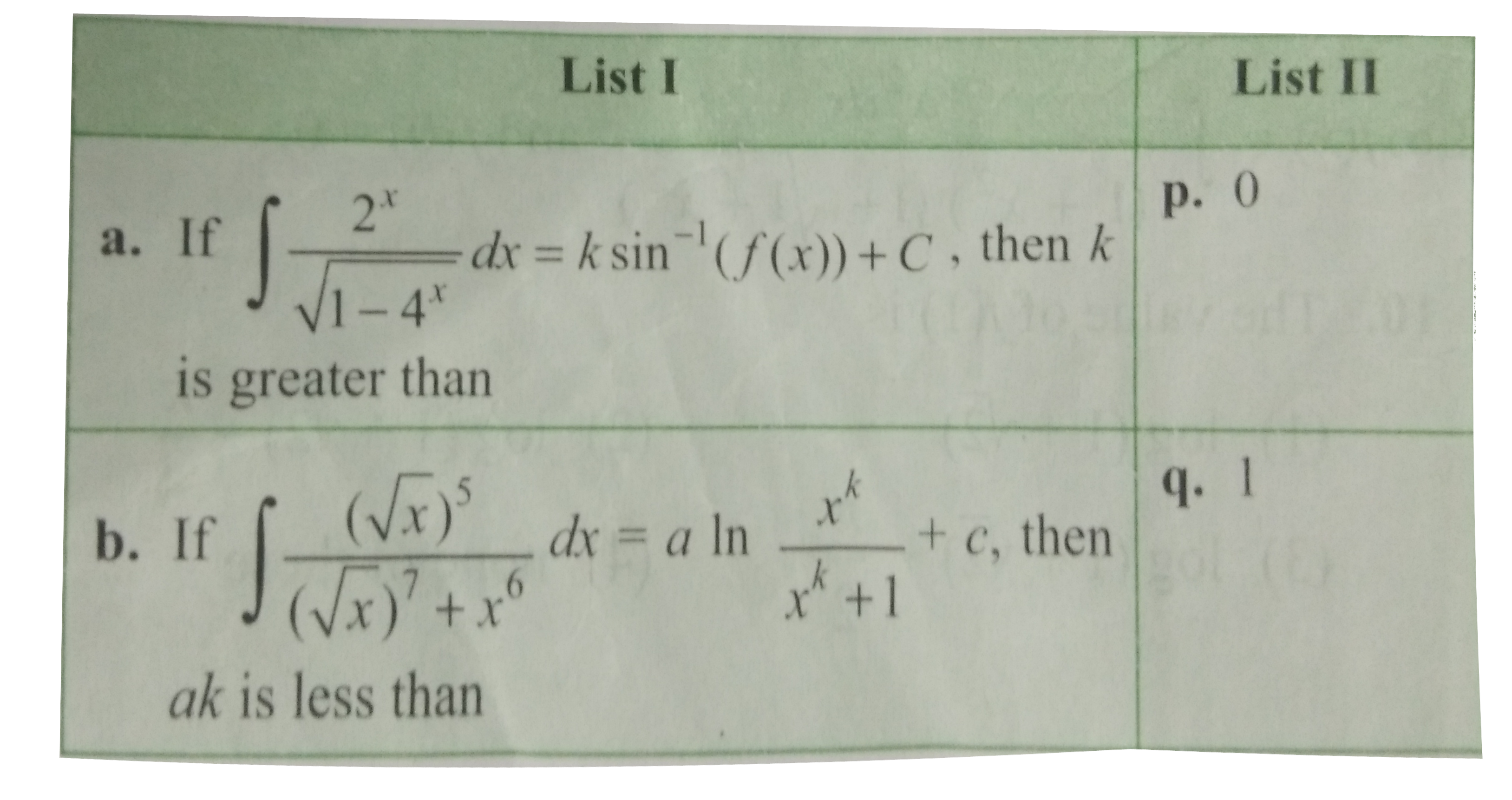If ∫ex−1(x2−5x+4)2xdx=AF(x−1)+BF(x−4)+C and F(x)=∫exxdx,thenSolution in Bengali
A=−2/3
B=(4/3)e3
A=2/3
B=(8/3)e3
The correct Answer is:A, D
2x(x−1)(x−4)=Cx−1+Dx−4
2x=C(x−4)+D(x−1)
∴C=−2/3,D=8/3
∴∫ex−1(x2−5x+4)2xdx=∫ex−1(−2/3x−1+8/3x−4)dx
=−23F(x−1)+83e3F(x−4)+C
∴A=−2/3,B=8/3e3
Topper's Solved these Questions
- INDEFINITE INTEGRATIONBook:CENGAGE PUBLICATIONChapter:INDEFINITE INTEGRATIONExercise:Exercises (Linked Comprehension Type)
Explore 17 Videos
- INDEFINITE INTEGRATIONBook:CENGAGE PUBLICATIONChapter:INDEFINITE INTEGRATIONExercise:EXERCISES (Matrix Match Type)
Explore 4 Videos
- INDEFINITE INTEGRATIONBook:CENGAGE PUBLICATIONChapter:INDEFINITE INTEGRATIONExercise:EXERCISES (Single Correct Answer Type)
Explore 77 Videos
- HYPERBOLABook:CENGAGE PUBLICATIONChapter:HYPERBOLAExercise:COMPREHENSION TYPE
Explore 2 Videos
- INEQUALITIES AND MODULUSBook:CENGAGE PUBLICATIONChapter:INEQUALITIES AND MODULUSExercise:Single correct Answer
Explore 21 Videos
Similar Questions
y=f(x) is a polynomial function passing through point (0, 1) and which increases in the intervals (1,2)and(3,∞) and decreases in the intervals (∞,1)and(2,3).
If f(1)=−8, then the value of f(2) is
View SolutionMatch the following lists:


View SolutionI=∫sin8x−cos8x1−2sin2xcos2xdx is equal to:
View SolutionThe circle x2+y2−8x=0 and hyperbola x29−y24=1 I intersect at the points A and B. Equation of a common tangent with positive slope to the circle as well as to the hyperbola is (A) 2x−√5y−20=0 (B) 2x−√5y+4=0 (C) 3x−4y+8=0 (D) 4x−3y+4=0
View SolutionIf f(x)=ax2+bx+c and f(−1)≥−4, f(1)≤0 and f(3)≥5, then the least value of a is
View SolutionIf ∫ex−1(x2−5x+4)2xdx=AF(x−1)+BF(x−4)+CandF(x)=∫exxdx,then (a)A=−23 (b) b=(43)e3 (c)A=23 (d) d∈R
View SolutionIf ∫ex−1(x2−5x+4)2xdx=AF(x−1)+BF(x−4)+c and F(x)=∫exxdx, then-
View SolutionSTATEMENT-1 : ∫dxex+e−x+2=−1ex+1+c
and
STATEMENT-2 : ∫d(f(x))(f(x))2=−1f(x)+c
View SolutionIf ∫f'(x)ex2dx=(x−1)ex2+c , then f (x) is
View SolutionIf ∫x3e5xdx−e5x54(f(x))+03 then f(x)=
View SolutionA: ∫ex(1+xlogxx)=exlogx+c
R: ∫ex[f(x)+f'(x)]dx=exf(x)+c
View SolutionIf ∫x3e5xdx=e5x54(f(x))+c, then f(x)=
View SolutionIf ∫f'(x)ex2dx=(x−1)ex2+c then f (x) is . . . . .
View SolutionI = int e^(x) { f (x) + f' (x) } dx can be found using segmented integration. As I = int e^(x) f (x) + dx + int e^(x) f' (x) dx = int e^(x) dx + e^(x) f (x) - int e^(x) f (x) dx + c = e^(x) f (x) + c And int e^(ax) { f (x) + (f' (x))/(a) }dx = a^(ax) (f(x))/(a) + c int e^(x) (tan^(-1) x + (1)/(1 + x^(2)) ) dx = :
View SolutionI = int e^(x) { f (x) + f' (x) } dx can be found using segmented integration. As I = int e^(x) f (x) + dx + int e^(x) f' (x) dx = int e^(x) dx + e^(x) f (x) - int e^(x) f (x) dx + c = e^(x) f (x) + c And int e^(ax) { f (x) + (f' (x))/(a) }dx = a^(ax) (f(x))/(a) + c int e^(x) (tan x - log cos x ) dx = : int e^(x) ((1 + sin x)/(1 + cos x )) dx = :
View SolutionIf ∫ex(x2−5x+8) dx = ex f(x) + c then f(x) =
View Solution